Polyurethane is a popular and versatile coating that is commonly used for various applications, including wood finishing, automotive coatings, and industrial coatings. One of the most common questions when using polyurethane is how long it takes for it to dry completely. In this article, we will explore the factors that affect the drying time of polyurethane and provide a detailed explanation of the drying process.
1. Understanding polyurethane
Polyurethane is a synthetic material made by reacting isocyanates with polyols. It can be formulated in various ways to achieve different properties such as flexibility, hardness, and durability. When used as a coating, polyurethane forms a protective layer that enhances the appearance and longevity of the substrate.
2. Factors affecting polyurethane drying time
Several factors can influence how long it takes for polyurethane to dry. These include:
- Humidity: High humidity levels can prolong the drying time of polyurethane as it hinders the evaporation of solvents.
- Temperature: Warmer temperatures generally accelerate the drying process, while colder temperatures slow it down.
- Thickness: The thickness of the polyurethane layer can affect drying time. Thicker layers take longer to dry compared to thinner ones.
- Ventilation: Proper ventilation helps in expediting the drying process by allowing the solvents to evaporate more efficiently.
- Type of polyurethane: Different types of polyurethane formulations have varying drying times. Water-based polyurethane typically dries faster than oil-based ones.
How long do water based poly take to dry
How long does the finish take to dry?
3. Drying stages of polyurethane
The drying process of polyurethane can be divided into several stages. Understanding these stages is crucial for determining when the coating is fully dry and ready for use.
3.1. Surface drying
During the initial stage, known as surface drying, the solvents in the polyurethane begin to evaporate, leaving behind a tacky surface. This stage typically lasts for 2-4 hours, but it may vary depending on the aforementioned factors.
3.2. Initial curing
After surface drying, the polyurethane enters the initial curing stage. In this stage, the coating starts to harden and becomes less tacky. Light use may be possible after 24 hours, but caution should still be exercised to prevent any damage to the surface.
3.3. Full curing
The final stage of polyurethane drying is full curing, where the coating achieves its maximum hardness and durability. Full curing can take anywhere from 7 to 30 days, depending on the environmental conditions and the type of polyurethane used. It is important to note that even though the coating may feel dry to the touch, it may still be vulnerable during this stage.
4. Tips for faster drying
If you need to expedite the drying time of polyurethane, here are some tips:
- Choose a water-based polyurethane as it generally dries faster than oil-based ones.
- Ensure proper ventilation in the drying area to facilitate solvent evaporation.
- Use fans or dehumidifiers to reduce humidity levels.
- Apply thin coats of polyurethane to speed up the drying process.
- Optimize temperature conditions by keeping the room warm (around 70-80°F) but not hot.
5. Conclusion
Polyurethane drying time can vary depending on several factors, including humidity, temperature, thickness, ventilation, and the type of polyurethane used. Understanding the drying stages and following the tips mentioned above can help ensure a successful and timely drying process. It is always recommended to consult the manufacturer’s instructions for specific drying time guidelines for the particular polyurethane product being used.

